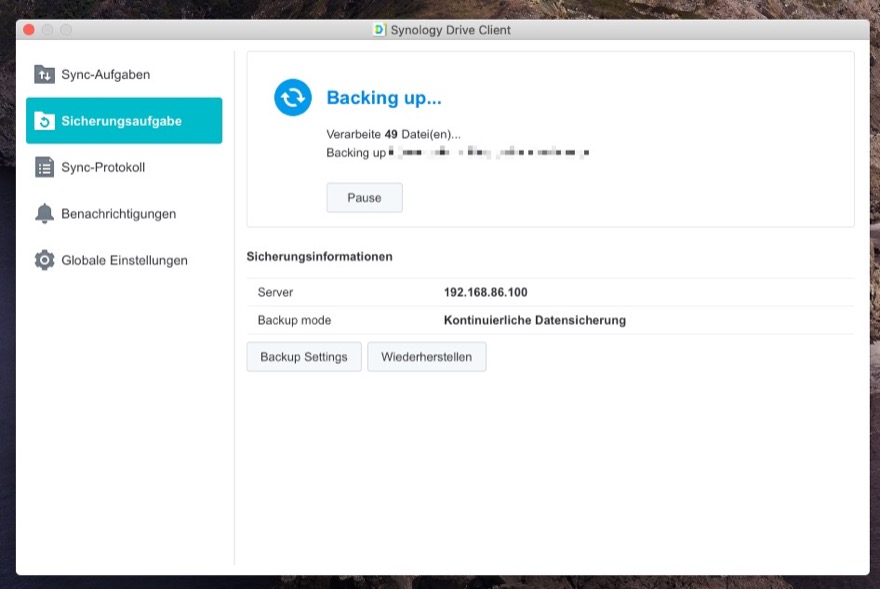

- SYNOLOGY DRIVE CLIENT WINDOWS HOW TO
- SYNOLOGY DRIVE CLIENT WINDOWS INSTALL
- SYNOLOGY DRIVE CLIENT WINDOWS PASSWORD
- SYNOLOGY DRIVE CLIENT WINDOWS PC
- SYNOLOGY DRIVE CLIENT WINDOWS WINDOWS 7
If you want to replicate files to Synology NAS with original format so that you can view and use them directly, use Basic Sync instead of backup.

Thus you can boot a crashed computer to Windows PE and restore it to an earlier state with the system image stored on NAS.
SYNOLOGY DRIVE CLIENT WINDOWS WINDOWS 7
If you are backing up Windows 7 OS to NAS, try creating a bootable media as well. Then click Start Backup and wait till the process ends. Optionally, you can Schedule an automatic backup, Set up a Scheme to auto delete older backups, or manage more backup Options.
SYNOLOGY DRIVE CLIENT WINDOWS PASSWORD
Click Add Network Location to input your IP address, username and password of Synology NAS, then click OK to confirm it.ĥ. Click the destination box and choose Share/NAS in the popping out window.Ĥ. If you choose System Backup in last step, the system partition will be automatically selected as source.ģ. Click Add Folder or Add File to specify what you want to backup. If you want to backup only OS to NAS in case of Windows failures, choose System Backup instead.Ģ. Here you can see some other choices like Partition Backup or Disk Backup. Then switch to Backup tab and choose File Backup.
SYNOLOGY DRIVE CLIENT WINDOWS INSTALL
Make sure you can connect to your Synology or other NAS, install and launch the tool.
SYNOLOGY DRIVE CLIENT WINDOWS HOW TO
How to backup data to NAS in Windows 7/8/10 within 5 steps:ġ. So you can simply download it and give it a shot. For example, you can schedule a daily backup to let it run automatically.Īnother thing I like about it is that, the free version already meets your basic need to backup operation system or important files to NAS. In addition to the intuitive interface, it also provides various options and auxiliary functions to save you from cumbersome operations. Therefore, you can easily implement 3-2-1 backup strategy with this freeware - AOMEI Backupper Standard. It works on all Windows OS including Windows 7/8/10/etc., and allows you to backup important data to not only Synology, but other NAS, network locations, cloud drives, external hard drives and so on. This is the fastest method with the widest range of applications, so I put it in the first place. Backup Windows 7 computer to NAS with Backup and Restore Use Synology Drive Client to backup data to NAS in Windows 7 Use effective freeware to backup Windows 7/8/10 to NAS What do you care about most when performing backup to NAS in Windows 7? Transferring speed, data safety, or the ease of use? In fact, all these requirements can be met. How to backup Windows 7 to NAS like Synology? When your Windows computer crashes, you can restore the system or files from NAS.īut what's the best free way to backup data to Synology and suchlike NAS in Windows 7?

You can access the data through network remotely.Ĭompared with PC, NAS storage is less likely to be damaged by accidents. It’s easier for file sharing between connected clients.
SYNOLOGY DRIVE CLIENT WINDOWS PC
There are some significant advantages to back up PC to NAS: As the name suggests, it’s a network connected storage that can be accessed via Internet. NAS is short for Network Attached Storage. You may not have to follow the strategy closely, but in Windows 7/8/10, backing up data to NAS (like Synology NAS) is definitely a good idea, no matter it’s a system image or a batch of important files. Still, there are cases, such as shared team projects, where you need spacious local storage, creating a more compelling need for the switch to a Synology NAS.According to 3-2-1 backup rule, it's safer to have at least three data copies - one for local and two for different devices. Even if you pay a monthly fee for Google Drive, it takes years to match what you'll pay for your own network storage. However, you don't need to pay a monthly fee when you have a NAS of your own, but there's an upfront cost attached, and it's a hefty one. The sweet spot is $10 a month or $100 a year for 2TB of data, which is cheaper than most 2TB HDDs. Plans go as high as $300 a month for 30TB of storage. The payment plans start at $2 a month or $20 yearly for 100GB of storage. Google One is a subscription service that includes Google Drive storage, Google VPN, and other niceties. If you need more storage space, check out Google One. It all boils down to how much value you place on your personal or business data and how important it is to keep your files in your own storage space instead of in someone else's cloud servers. It has plenty of integrated bells and whistles, and the introductory rates are affordable. Google Drive could be your best bet for purposes requiring less than a terabyte of data. This is particularly true if you need the tool for a single purpose, like backing up data. Google Drive is easily accessible and may be a more feasible option for many users when compared with a Synology NAS (Network-Attached Storage).


 0 kommentar(er)
0 kommentar(er)
